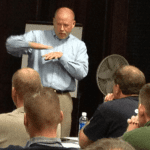 The topic of situational awareness is growing in popularity in the fire service and this is a good thing. For decades the casualty reports have revealed that flawed situational awareness leads to poor decision making and has contributed to tragic fireground outcomes. I am honored to see many of the teachings being shared here on the SAMatters website (and in my books and videos) are becoming part of mainstream teachings for firefighters. But I have some concerns as well.
The topic of situational awareness is growing in popularity in the fire service and this is a good thing. For decades the casualty reports have revealed that flawed situational awareness leads to poor decision making and has contributed to tragic fireground outcomes. I am honored to see many of the teachings being shared here on the SAMatters website (and in my books and videos) are becoming part of mainstream teachings for firefighters. But I have some concerns as well.
I have a concern
I have some concerns because I have sat in on some classes and read some articles where the instructor/author is throwing around the term “situational awareness” with little understanding of the complexities of human cognition and how challenging situational awareness can be. One testimonial of the complexity of this topic may be the fact that I have been able to write over 300 articles, author five books and produce two DVD training programs– all dedicated to the topic of situational awareness. It is a complex topic to understand – and to teach.
Fifteen years ago, I would have been one of those instructors throwing around the situational awareness “buzzword” while sharing with my students what I “thought” I knew because I had read an article or two on the topic. Only after conducting seven years of extensive research on the neuroscience of human cognition can I now say I understand enough to comfortably teach this topic comprehensively.
Come on, teach it right!
I don’t expect all fire service instructors who teach situational awareness to earn a Ph.D. in order to do so. But I do expect that when they decide to take on the task of teaching a complex and critically important topic that they teach it accurately. Some of the articles I have read or classes I have attended are so superficial that it gives the appearance that so long as you “pay attention” or “keep your head on a swivel” or “look up, down, and all around” that you will be able to develop and maintain situational awareness. This is a fallacy.
I amply demonstrate this during my Mental Management of Emergencies and Flawed Situational Awareness programs by conducting demonstrations where I “steal away” the situational awareness of the students. When I do this, I tell the class that I am conducting a demonstration. I tell them to be sure to “pay attention” and to “keep their heads on a swivel” and to “look up, down and all around” and then I steal their situational awareness away.
I have attended classes (where I am the student) and other students ask the instructor a question about situational awareness or ask the instructor to explain the reason certain phenomenon occur and the explanations given are, simply, wrong. Sadly, some instructors would prefer to make up an answer instead of saying “I don’t know the answer to that.” On the topic of situational awareness, providing the student with a made-up answer is reckless and can be dangerous.
Even though I have studied the cognitive neuroscience of decision making extensively, I still have students ask me questions that I do not know the answer to. When that happens, I am quick to say “That’s a great question and I have a really lousy answer. I don’t know the answer.” Just because an instructor has decades of experience doesn’t mean their opinions are supported by science.
It’s tragic
 I have been told there are instructors using some of my demonstrations in their classes, not to teach, but to entertain their students. I think this is tragic. During my full-day classes, the demonstrations are always followed by a thorough explanation of the neuroscience that gave rise to the outcome. (I do this, by the way, in a very first responder friendly way.)
I have been told there are instructors using some of my demonstrations in their classes, not to teach, but to entertain their students. I think this is tragic. During my full-day classes, the demonstrations are always followed by a thorough explanation of the neuroscience that gave rise to the outcome. (I do this, by the way, in a very first responder friendly way.)
The lessons are too important to chance someone will misunderstand complex terms or concepts so I go to painstaking efforts to make sure the lessons are easy to understand. But, nonetheless, there are always lessons tied to the demonstrations and best practices for how to avoid some of the challenges for developing and maintaining situational awareness.
Barriers
When I enrolled in my doctoral program I learned that I needed to conduct “original research” which meant I had to discover something that no one had ever previously discovered. My discovery was the “barriers” that prevent the formation of situational awareness can destroy situational awareness, or can keep situational awareness from being reformed once it is lost.
There are over 100 barriers to situational awareness. Some are more challenging than others. Some can be prevented while others cannot. For those that cannot be prevented, (I lump those into a category that I term “human factors”) the best I can do in a class is make the students aware of their vulnerabilities and share some viable workarounds.
It’s not a sexy topic
 One of the challenges I continually face is how to get first responders to get immersed into the topic of situational awareness. While flawed situational awareness (and the barriers) are leading contributing factors in near-miss and casualty reports, the topic does not lend itself to being very, for the lack of a better word, “sexy.”
One of the challenges I continually face is how to get first responders to get immersed into the topic of situational awareness. While flawed situational awareness (and the barriers) are leading contributing factors in near-miss and casualty reports, the topic does not lend itself to being very, for the lack of a better word, “sexy.”
I understand that most firefighters, if given the choice, would rather do training where hose lines are taken into smoke-charged buildings, and this is very important training, indeed. But some of those same firefighters would never sit in a classroom to learn about situational awareness barriers. Thus, they learn and practice a lot about how to put out fires and know little about how their own cognitive shortcomings might cause them to do something extremely dangerous or even catastrophic (especially under stress).
Dr. Gasaway’s Advice
 If you attend a program focused on safety and you find the instructor is throwing around the situational awareness term without providing comprehensive explanations for how to develop and maintain it, be skeptical of what you are being taught. I doubt the instructor will teach you anything wrong on purpose, but know their teachings can do more harm than good.
If you attend a program focused on safety and you find the instructor is throwing around the situational awareness term without providing comprehensive explanations for how to develop and maintain it, be skeptical of what you are being taught. I doubt the instructor will teach you anything wrong on purpose, but know their teachings can do more harm than good.
Situational awareness occurs within the mind of an individual, which means to understand it and to explain it (properly) requires a rather thorough understanding of cognitive neuroscience. It also requires the instructor to have the ability to make all that B.S. (Brain Science) easy for the average firefighter to understand.
Action Items
 1. Discuss and develop your own working definition for situational awareness (here’s a hint: It’s more than paying attention to your surroundings.)
1. Discuss and develop your own working definition for situational awareness (here’s a hint: It’s more than paying attention to your surroundings.)
2. Discuss the challenges you’ve experienced with developing and maintaining situational awareness.
3. Use the Search feature or the Category feature on this website to identify an article that addresses a challenging situational awareness barrier and hold a discussion with your crew about the barrier.
_____________________________________________________

If you are interested in taking your understanding of situational awareness and high-risk decision making to a higher level, check out the Situational Awareness Matters Online Academy.
CLICK HERE for details, enrollment options and pricing.
__________________________________
Share your comments on this article in the “Leave a Reply” box below. If you want to send me incident pictures, videos or have an idea you’d like me to research and write about, contact me. I really enjoy getting feedback and supportive messages from fellow first responders. It gives me the energy to work harder for you.
Thanks,

Email: Support@RichGasaway.com
Phone: 612-548-4424
SAMatters Online Academy
Facebook Fan Page: www.facebook.com/SAMatters
Twitter: @SAMatters
LinkedIn: Rich Gasaway
Instagram: sa_matters
YouTube: SAMattersTV
iTunes: SAMatters Radio
iHeart Radio: SAMatters Radio
